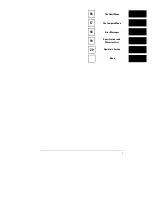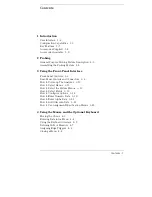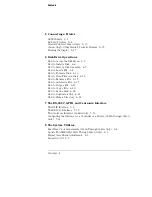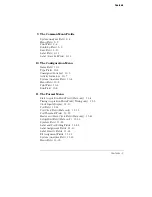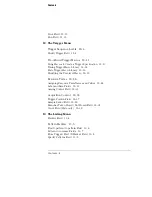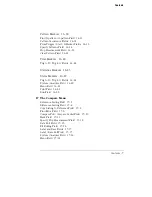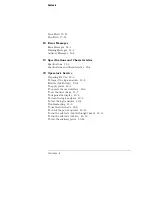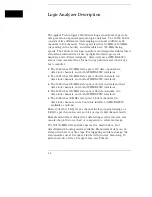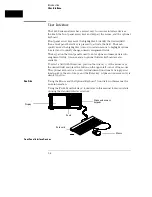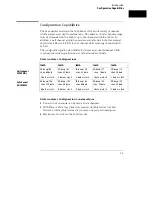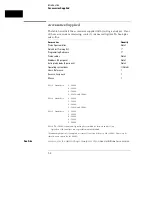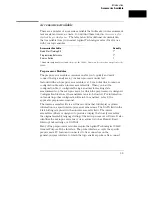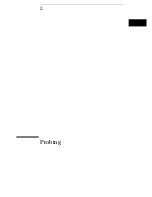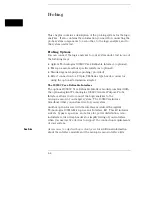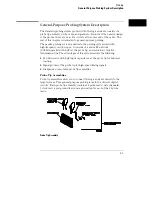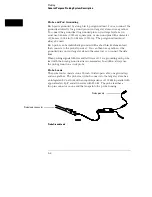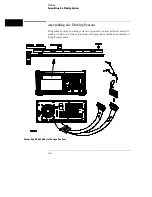
Configuration Capabilities
The five analyzer models in the 1660 Series offer a wide variety of channel
widths and memory depth combinations. The number of data channels range
from 34 channels with the 1664A, up to 136 channels with the 1660A. In
addition, a half channel acquisition mode is available which doubles memory
depth from 4 Kbytes to 8 Kbytes per channel while reducing channel width
by half.
The configuration guide below illustrates the memory depth/channel width
combinations in all acquisition modes with all analyzer models.
State Analyzer Configurations
1660A
1661A
1662A
1663A
1664A
8K-deep / 68
chan. 65 data
+
3 data or clock
8K-deep / 51
chan. 48 data
+
3 data or clock
8K-deep / 34
chan. 32 data
+
2 data or clock
8K-deep / 17
chan. 16 data
+
1 data or clock
8K-deep / 17
chan. 16 data
+
1 data or clock
4K-deep / 136
chan. 130 data
+
6 data or clock
4K-deep / 102
chan. 96 data
+
6 data or clock
4K-deep / 68
chan. 64 data
+
4 data or clock
4K-deep / 34
chan. 32 data
+
2 data or clock
4K-deep / 34
chan. 32 data
+
2 data or clock
State Analyzer Configuration Considerations
•
Unused clock channels can be used as data channels.
•
With Time or State tags turned on, memory depth is reduced by half.
However, full depth is retained if you leave one pod pair unassigned.
•
Maximum of 6 clocks in the 1660A model.
Half channel
50/100 MHz
Full channel
50/100 MHz
Introduction
Configuration Capabilities
1–5
Summary of Contents for 1660A Series
Page 5: ...vi...
Page 14: ...1 Introduction...
Page 24: ...2 Probing...
Page 35: ...Probing Assembling the Probing System 2 12...
Page 36: ...3 Using the Front Panel Interface...
Page 65: ...3 30...
Page 66: ...4 Using the Mouse and the Optional Keyboard...
Page 74: ...5 Connecting a Printer...
Page 91: ...5 18...
Page 92: ...6 Disk Drive Operations...
Page 118: ...7 The RS 232C GPIB and Centronix Interface...
Page 121: ...RS 232 GPIB Menu Map Cont The RS 232C GPIB and Centronix Interface 7 4...
Page 123: ...Printer Controller Menu Map Cont The RS 232C GPIB and Centronix Interface 7 6...
Page 132: ...8 The System Utilities...
Page 137: ...9 The Common Menu Fields...
Page 150: ...9 14...
Page 151: ...10 The Configuration Menu...
Page 159: ...11 The Format Menu...
Page 161: ...Format Menu Map The Format Menu 11 3...
Page 194: ...11 36...
Page 195: ...12 The Trigger Menu...
Page 198: ...Trigger Menu Map The Trigger Menu 12 4...
Page 199: ...Trigger Menu Map Continued The Trigger Menu 12 5...
Page 235: ...13 The Listing Menu...
Page 237: ...Listing Menu Map The Listing Menu 13 3...
Page 260: ...13 26...
Page 261: ...14 The Waveform Menu...
Page 263: ...Waveform Menu Map The Waveform Menu 14 3...
Page 264: ...Waveform Menu Map cont The Waveform Menu 14 4...
Page 300: ...14 40...
Page 301: ...15 The Mixed Display Menu...
Page 306: ...15 6...
Page 307: ...16 The Chart Menu...
Page 310: ...Chart Menu Map The Chart Menu 16 4...
Page 311: ...Chart Menu Map cont The Chart Menu 16 5...
Page 336: ...16 30...
Page 337: ...17 The Compare Menu...
Page 340: ...Compare Menu Map The Compare Menu 17 4...
Page 355: ...18 Error Messages...
Page 363: ...19 Specifications and Characteristics...
Page 377: ...20 Operator s Service...
Page 386: ...Troubleshooting Flowchart 1 Operator s Service To use the flowcharts 20 10...
Page 387: ...Troubleshooting Flowchart 2 Operator s Service To use the flowcharts 20 11...

